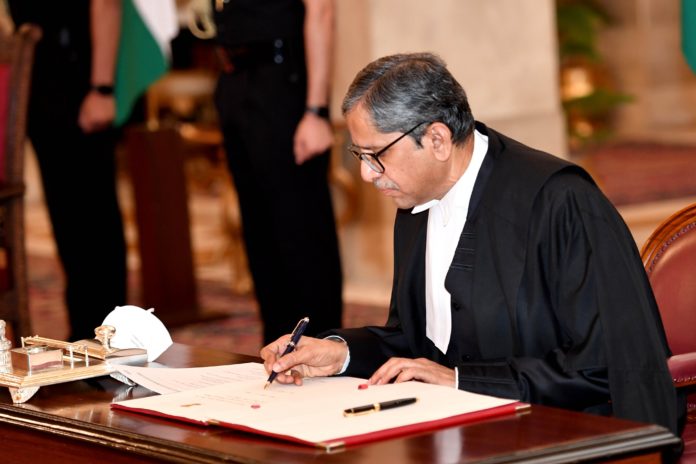
Taking the oath on April 24, Nuthalapati Venkata Ramana, 63, was appointed as 48th Chief Justice of India by President Ram Nath Kovind at a brief ceremony that took place at Rashtrapati Bhawan. He succeeds CJI SA Bobde who retired from office on Friday.
Justice N V Ramana will demit office on August 26, 2022. Earlier, he had been the Chief Justice of the Delhi High Court and the serving Chief Justice of the Andhra Pradesh High Court. He was born in an agricultural family in Andhra Pradesh’s Krishna district and had practiced in the state High Court as well as the Apex Court for numerous years. After Justice K Subba Rao, who was the ninth Chief Justice of India during 1966-67, Justice NV Ramana became the second Chief Justice of India from Andhra Pradesh.
Justice Ramana was looked like an activist profile during his student days and including himself in cases affecting farmers and industrial workers. He started his career as a journalist for a prominent Telugu newspaper for a particular time period prior to undertaking the legal practice. Registered himself as an advocate on February 10, 1983, he was given the charge as a permanent Judge of the Andhra Pradesh High Court on June 27, 2000, and headed as acting Chief Justice of the Andhra Pradesh High Court from March 10, 2013 to May 20, 2013.
“He was elevated as the Chief Justice of Delhi High Court on September 2, 2013 and was elevated as a Judge of the Supreme Court on February 17, 2014. He has specialised in Constitutional, Criminal, Service and Inter-State River laws and has also been associated with several government organisations as a counsel,” Justice Ramana’s profile on the official website of the Supreme court reads.
Justice Ramana has been a part of numerous historic judgements. He was part of a bench that constituted a three-member committee to consider the demand for permitting 4G mobile internet in Jammu and Kashmir and directed that suspension of the internet in Jammu and Kashmir should be assessed immediately. He was also part of the panel of judges which stated that the Chief Justice’s office comes under the boundaries of the Right to Information Act.
He had also been in controversy, after the chief minister of Andhra Pradesh YS Jagan Mohan Reddy wrote to the CJI SA Bobde alleging that the judge and his kin were associated with the Amaravati land scam case. However, Justice Ramana had rebutted the allegations stating that judges had become “soft targets” for criticism and gossip mongers.
Recently, the AP government had reportedly requested the apex Court to withdraw the stay imposed by the state High Court on the investigation. Justice Ramana’s nomination also implied that the allegations have been categorically rejected by former CJI SA Bobde.
In Shiv Sena v. Union of India, Justice Ramana drew the sign of the floor test to restrict unlawful practices such as horse-trading and to effectuate the flexible running of democracy in the court. The order was issued post an urgent hearing in light of the political logjam developed after the Maharashtra assembly elections of 2019.
“We are going through testing times as we battle the Covid wave. Lawyers, judges and court staff are all affected due to the virus. Some hard measures may be necessary to break the chain of transmission. We can defeat the pandemic together with dedication,” said Justice Ramana, in farewell to former CJI SA Bobde.
Another task which Justice NV Ramana could look for is to fill up the six vacancies that are vacant in the apex court, and during Justice SA Bobde’s tenure, not a single judge was placed to the apex court.









